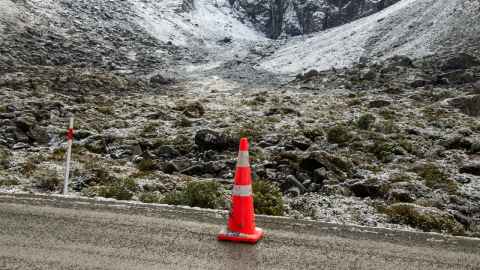WorkSafe’s road cone hotline a bright orange distraction
6 June 2025
Opinion: Just as NZ’s absurd safety culture is moving from rigid compliance to professional judgement, WorkSafe launches a tip line undermining that very shift, according to Tim Welch.

Opinion: WorkSafe’s new road cone tip line launched this week, inviting citizens to dob in excessive cone use. It is perhaps the perfect populist solution to a complex problem – except it fundamentally misunderstands why it feels like we are drowning in orange plastic in the first place.
Yes, we spent $786 million on road cones and temporary traffic management on state highways over three years. Yes, some people believe we’ve earned the nickname ‘Cone Zealand’. And yes, people in power from the Prime Minister to Auckland’s mayor earnestly argue that roads are being clogged with cones when no work seems to be in progress.
But asking frustrated motorists to judge whether a worksite has too many cones is like asking plane passengers to report on a pilot’s landing procedure. It might feel satisfying, but it’s almost certainly a waste of everyone’s time.
We need regulations that trust professional judgement, not a hotline that treats road safety like reality TV.
What cone-haters don’t realise is those seemingly excessive orange armies are actually doing their job. Between 2019 and 2023, there were 42 fatal and 314 serious crashes at roadwork sites. That’s a gut-wrenching statistic, but here’s what those little plastic pyramids would want you to know: 95 percent of those killed or injured were road users, not workers.
The 2024 audit of worksites found 145 of 800 sites had “unnecessary” traffic management, which has been used to argue the need to reduce cone usage. Doing the maths tells a different tale. It means 82 percent of sites were using appropriate controls. In the brutal calculus of road safety, the cones are keeping workers alive. The problem is, to some degree, they might be protecting workers at the expense of the rest of us – creating confusion, sudden lane changes, and the crashes that follow.
To understand how we got here, you need to appreciate the beautiful absurdity of New Zealand’s safety culture. The Code of Practice for Temporary Traffic Management started in 2000 as a sensible standardisation effort. By the time it was replaced in 2023, it had metastasised from 515 clauses to 1450. That’s not a typo. One thousand, four hundred and fifty separate requirements for putting out cones (and other temporary traffic management).
We need regulations that trust professional judgement, not a hotline that treats road safety like reality TV.
Under this regime, an 80 km/h road required a 40m cone taper with cones every 5m, plus a 20m working space. That’s at least 12 cones just for the approach, before you even get to the actual work area. A two-person pothole repair could easily require 30-plus cones, turning a 30-minute job into a fortress of orange. The regulations left no exceptions. No room for professional judgement. Just follow the recipe or face liability.
This prescriptive madness took root in our post-Pike River world, where zero-risk thinking infected every industry. An unfortunate side effect was the creation of a lucrative traffic management industry where subcontractors charged by the cone. The system has been described as a “self-feeding organism” where those who profit from traffic management also decided how much was needed. It’s like letting McDonald’s decide your daily calorie intake – what could go wrong?
The NZ Transport Agency switched to risk-based guidelines in 2023, appropriately replacing the impossibly long name of the previous regulations with something just as hard to remember, the New Zealand Guide to Temporary Traffic Management. Under the new policy, traffic management costs dropped from 15.9 percent to 9.9 percent of project spending in just one quarter. Boring, bureaucratic changes like this will do more to reduce cone overuse than any number of angry phone calls from motorists.
The irony is that just as we’re finally moving from rigid compliance to professional judgement – letting traffic managers actually think about what’s needed rather than blindly following a 1450-clause rulebook – WorkSafe launches a tip line that undermines that very shift. We’re simultaneously telling contractors “use your professional judgement” while inviting every frustrated motorist to second-guess that judgement.
What we’ll likely see from the tip line is a flood of calls from annoyed drivers, but few, if any, actionable hot tips. A similar ‘cones hotline’ in the UK in the 1990s became notorious for its ineffectiveness, reportedly removing just one cone for every 3400 calls. There’s little reason to expect different results here, especially when the real issue isn’t individual sites but systemic incentives.
The $786-million question isn’t how many cones are too many – it’s why contractors get paid by the cone in the first place. WorkSafe says the tip line is about “education, not enforcement” but contractors who’ve spent two decades following 1450 rules won’t suddenly embrace flexibility because Barry from Remuera lodged a complaint.
What we need are contracts that reward efficiency, not equipment rental. We need regulations that trust professional judgement, not a hotline that treats road safety like reality TV.
Those 42 people weren’t killed by too many cones – they were failed by a system that chose blind compliance over common sense. Now we’re asking the public to fix what decades of bureaucracy created. In a country that once mandated exactly how to place every single cone, the solution apparently is a complaints hotline. Perhaps we deserve all the cones we get.
Dr Timothy F. Welch is a Senior Lecturer in the School of Architecture and Planning, Faculty of Engineering and Design.
This article reflects the opinion of the author and not necessarily the views of Waipapa Taumata Rau University of Auckland.
This article was first published on Newsroom, WorkSafe’s road cone hotline a bright orange distraction, 6 June 2025.
Media contact
Margo White I Research communications editor
Mob 021 926 408
Email margo.white@auckland.ac.nz